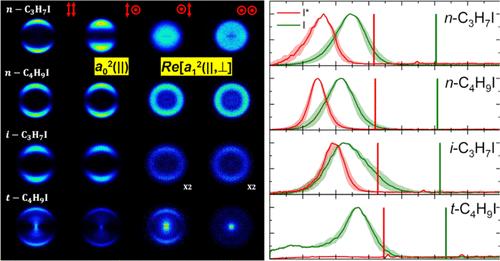254 和 268 纳米激发波长下烷基碘化物光解离的能量处置和原子光碎片排列的结构效应
IF 2.7
2区 化学
Q3 CHEMISTRY, PHYSICAL
引用次数: 0
摘要
这项研究工作标志着我们在理解第一吸收波段烷基碘化物的广泛研究光动力学方面又向前迈进了一步。通过结合共振增强多光子电离 (REMPI) 检测原子光碎片 I(2P3/2) 和 I*(2P1/2)以及脉冲切片成像,研究了几种烷基碘化物 (RI) 的紫外线 (UV) 光解离,特别是一系列 R = CnH2n+1, n = 1-4 的线性和柱状分子。对这两种原子光分量的总平移能量分布的详细研究与从各向异性 β 和配位 a02(∥) 和 Re[a12(∥, ⊥)]参数中获得的过程的立体动力学信息相结合,描述了烷基碘化物的分子结构在绝热,特别是在通过锥形交叉或避免交叉的非绝热光解离动力学中所起的作用。目前的研究结果表明,线性结构与纯 C-I 反应坐标的耦合更为有效,而对于支链结构,与附加振动(弯曲)模式的耦合则更为重要,这表明解离过程具有多维特性。此外,还发现小型线性 CH3I 和 C2H5I 的共碎片旋转配位程度很高,而且出乎意料的是,支链 t-C4H9I(C3v 对称性)的配位程度也很高,而其他烷基碘化物的配位参数较低。本文章由计算机程序翻译,如有差异,请以英文原文为准。

Structural Effects on the Energy Disposal and Atomic Photofragment Alignment for the Photodissociation of Alkyl Iodides at Excitation Wavelengths of 254 and 268 nm
This work represents a step forward in the understanding of the widely studied photodynamics of alkyl iodides in the first absorption band. Ultraviolet (UV) photodissociation of several alkyl iodides (RI), specifically, a series of linear and ramified molecules with R = CnH2n+1, n = 1–4, at excitation wavelengths of 254 and 268 nm, which correspond to the maximum of the first absorption A-band, has been studied by combining resonance-enhanced multiphoton ionization (REMPI) detection of atomic photofragments I(2P3/2) and I*(2P1/2) and of pulsed slice imaging. Detailed examination of the total translational energy distributions of both atomic photofragments has been combined with stereodynamical information on the process obtained from the anisotropy β and alignment a02(∥) and Re[a12(∥, ⊥)] parameters to provide a description of the role played by the molecular structure of alkyl iodides in adiabatic and, especially, in nonadiabatic photodissociation dynamics through conical intersections or avoided crossings. The present results suggest that the linear structures couple more efficiently with the pure C–I reaction coordinate, whereas for the branched structures, the coupling with additional vibrational (bending) modes gains importance, showing the dissociation process a multidimensional character. In addition, a large degree of cofragment rotational alignment has been found for the small linear CH3I and C2H5I and, unexpectedly, for the branched t-C4H9I (C3v symmetry), whereas the rest of the alkyl iodides show low alignment parameters.
求助全文
通过发布文献求助,成功后即可免费获取论文全文。
去求助
来源期刊

The Journal of Physical Chemistry A
化学-物理:原子、分子和化学物理
CiteScore
5.20
自引率
10.30%
发文量
922
审稿时长
1.3 months
期刊介绍:
The Journal of Physical Chemistry A is devoted to reporting new and original experimental and theoretical basic research of interest to physical chemists, biophysical chemists, and chemical physicists.
 求助内容:
求助内容: 应助结果提醒方式:
应助结果提醒方式:


